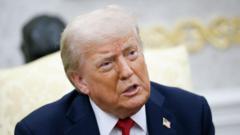In the latest report, China’s economy is projected to expand at an annual rate of 4.1%, maintaining momentum through strategic investments despite external pressures.
China's Economy Shows Resilience Amid U.S. Tariffs

China's Economy Shows Resilience Amid U.S. Tariffs
China's economic growth continues despite President Trump's tariffs, showing a diversification that strengthens its position.
China's economy demonstrated surprising resilience this past spring as it grew steadily despite facing challenges posed by steep tariffs from President Trump. Official figures indicate that strong investments in factories and high-profile infrastructure projects, including new high-speed rail lines, have contributed to this robustness. Anticipating the looming tariffs, many buyers quickened their orders in the first quarter of the year, further propelling growth.
As the U.S. grapples with rising inflation—a consequence of tariff impacts—China's GDP report highlights a contrasting narrative. The economy is expected to expand at approximately 4.1% annually, a slight moderation from earlier growth rates. This performance contrasts sharply with the U.S. market, where inflation data reveals significant price hikes on consumer goods like household furnishings.
In a notable policy reversal, the Trump administration recently permitted Chinese tech firms to resume purchases of Nvidia’s AI chips, after initially restricting sales. Meanwhile, in a separate development, Beijing announced plans to limit the transfer of key technologies essential for manufacturing electric vehicle (EV) batteries. This could present challenges for Chinese EV manufacturers, especially as the EU is pushing these companies to establish factories overseas.
Additionally, Australian Prime Minister Anthony Albanese made a visit to China to strengthen diplomatic ties, all while navigating pressures from the U.S., further showcasing the intricacies of international relations amid economic shifts.
The current state of affairs highlights the intricate balance between economic growth in China and its interactions on the global stage, particularly with the U.S. and allies like Australia.
As the U.S. grapples with rising inflation—a consequence of tariff impacts—China's GDP report highlights a contrasting narrative. The economy is expected to expand at approximately 4.1% annually, a slight moderation from earlier growth rates. This performance contrasts sharply with the U.S. market, where inflation data reveals significant price hikes on consumer goods like household furnishings.
In a notable policy reversal, the Trump administration recently permitted Chinese tech firms to resume purchases of Nvidia’s AI chips, after initially restricting sales. Meanwhile, in a separate development, Beijing announced plans to limit the transfer of key technologies essential for manufacturing electric vehicle (EV) batteries. This could present challenges for Chinese EV manufacturers, especially as the EU is pushing these companies to establish factories overseas.
Additionally, Australian Prime Minister Anthony Albanese made a visit to China to strengthen diplomatic ties, all while navigating pressures from the U.S., further showcasing the intricacies of international relations amid economic shifts.
The current state of affairs highlights the intricate balance between economic growth in China and its interactions on the global stage, particularly with the U.S. and allies like Australia.




















